公開日 2021年11月12日
Jomon Period
Hunting and Gathering Life
About 12,000 years ago, the Japanese archipelago began to be disconnected from the continent as the temperature and the sea level gradually rose.Such changes in climate and topography greatly affected the ecosystem of flora and fauna.Coniferous forests common in the cold area were pushed farther to the north, and deciduous broadleaf forests with oaks, beech trees, and elms expanded.In autumn, they bore edible nuts such as acorns and chinquapins, which became new types of food unavailable in the Stone Age.Large-sized animals decreased in number, while small and medium-sized animals like boars, deer, and hares increased.
Started 12,000 years ago, this long period lasting for 10,000 years is called the Jomon period, during which people’s lives changed greatly, adapting themselves to the new environment.One example is the invention of earthenware. The earthenware excavated from the Miyanomae site on the precincts of Sannomiya Hibita Shrine is one of the oldest not only in Japan but also in the world.Thanks to the invention of earthenware, people could cook foodstuffs easily to eat.
A large number of arrowheads made of stone were discovered in the same site.Bows and arrows were the innovative inventions to hunt small and medium-sized animals which ran very fast.The remains of a workshop that produced arrowheads were discovered in the Sannomiya Shimoyato site, which is several hundred meters away from the Miyanomae site.
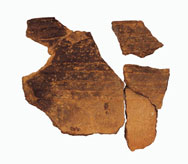
- Earthenware excavated from the Sannomiya Miyanomae site.

- Arrowheads made of stone excavated from the Sannomiya Miyanomae site.
They were invented by people to adapt their lives to the new surroundings.
Settlement and the Development of Villages
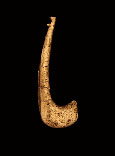
- The hook made of a deer’s antler, used for catching big fish, was unearthed at the Sannomiya Miyanomae site.
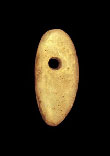
- The jade pendant, 5.4cm long, probably worn as a charm, was excavated from the Sannomiya Miyanomae site.
In Isehara, about 8,000-year-old remains of dwellings were found in Shiroganeyama, Takamori.It seems people began to make pit dwellings to settle down at this time.About 4,000 to 5,000 years ago, many dwellings were made in Hibita, Isehara, and Okazaki. About 3,000 years ago big villages were established in Hachimandai, Higashi-Otake and in Shimokitahara, Hinata.People gathered nuts and edible wild plants in the mountains and forests.They hunted animals, caught fish in the sea, and dug shellfish on the beach.Fish-hooks made of a deer’s antler were excavated together with sharks’ teeth from the remains in Isehara.It is considered that full-scale villages were established when they could obtain food constantly, blessed with a good natural environment.
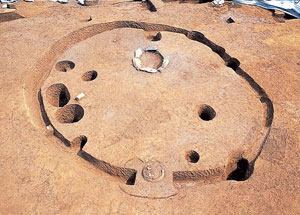
A pit dwelling found in the Kaminarimatsu site, Kami-Kasuya, has a hearth encircled by stones.
(Investigated by Tamagawa Cultural Assets Research Center, Inc.)
They exchanged with people living far away, as the following excavated artifacts show: stone tools made of obsidians from the Shinshu, Hakone, and Kozu-jima Island areas; accessories made of jade from the Itoigawa area; earthenware with designs unique to the Aomori area.Dwellings with stone-paved floors and graves built of stones were also found.Pierced earrings made of clay and small artistic pottery were excavated from a grave-pit of the Sannozuka site in Hachimandai together with teeth and part of the bones.Small female figures made of clay were unearthed at the Kumonji site in Tsubonouchi, and the Komagata site in Ikebata.Presumably, they were made to comfort the spirits of the deceased and to wish for bountiful blessings of nature and childbirth.
In the late Jomon period, the temperature started to drop again, and the number of the remains to be discovered decreased drastically in the Kanto region.No remains from this period have been found in Isehara so far, leaving a big question as to what happened to those people who settled in the big villages.

- Pottery, 8.7cm in height, with a beautiful design, was dedicated to the deceased.
It was excavated from the Sannozuka site.
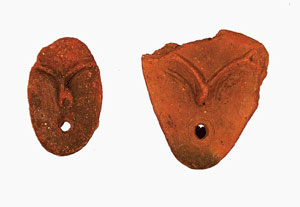
- Clay figures show human faces.
The one on the left is 4.6cm long.
They were excavated from the Komagata site in Ikebata and the Kumonji site in Tsubonouchi.
Next⇒Yayoi Period
- Geogaraphical Features of Isehara
- Paleolithic Period
- Jomon Period
- Yayoi Period
- Kofun (Tumulus)Period
- Nara Period
- Heian Period
- Kamakura Period
- Muromachi Period
- Civil War Period
- Edo Period
- Meiji, Taisho, and Showa Periods
Previous⇒Paleolithic Period


